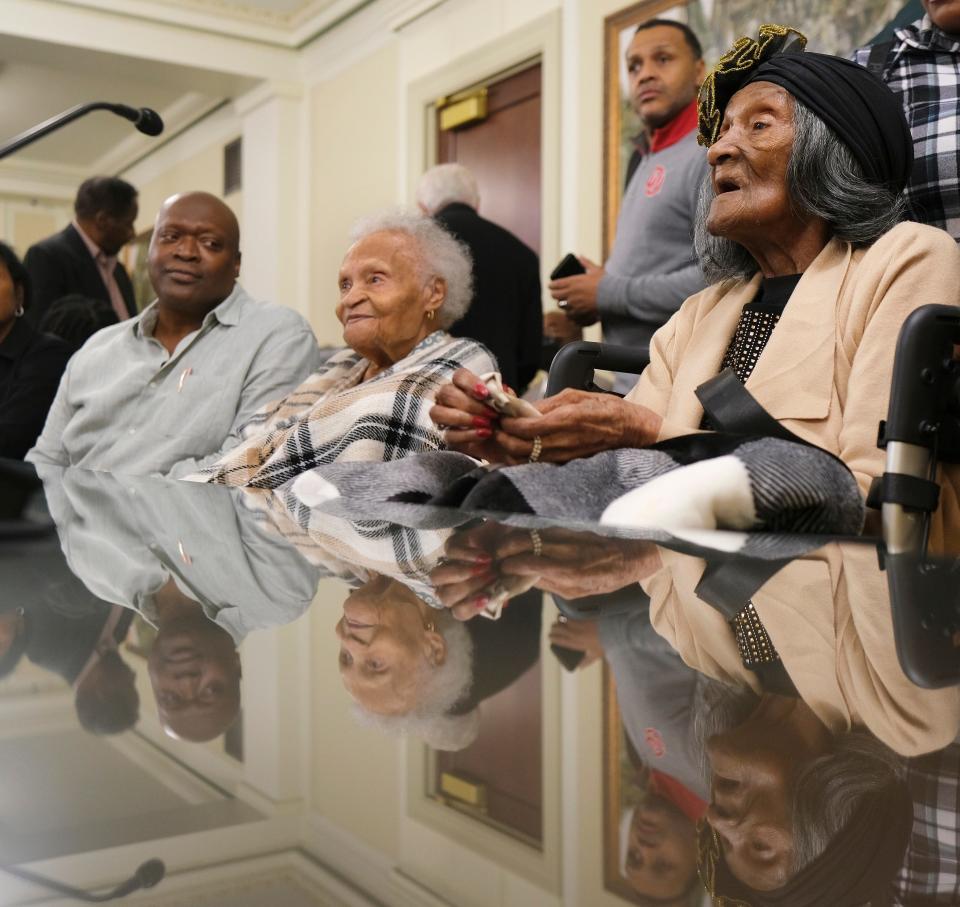Attorneys for survivors of the 1921 Tulsa Race Massacre plead to keep their lawsuit alive
Attorneys for the last two survivors of the 1921 Tulsa Race Massacre sought help from the Oklahoma Supreme Court on Tuesday, seeking to convince the court to keep their lawsuit alive. The survivors sued the city of Tulsa, the Tulsa County Board of Commissioners, the state's Military Department and the Tulsa Regional Chamber of Commerce.

But attorneys for the city of Tulsa, Tulsa County and the state's Military Department countered that public entities were immune from prosecution due to the old sovereign immunity statutes, which say that a state cannot be sued without its consent.
Lessie Benningfield Randle and Viola Fletcher, both who survived the 1921 Tulsa Race Massacre, appealed to the state's high court after Tulsa County Judge Caroline Wall dismissed their case in July 2023. At that time, Wall ruled that Randle and Fletcher, who are both 109, had failed to show how their claims could be remedied by the court.
The state Supreme Court later reinstated the case acknowledging that Randle and Fletcher were being subjected to a standard not imposed on other plaintiffs. A third plaintiff in the case, Hughes Van Ellis, also a survivor of the massacre, died last October.
The pair's attorney, Damario Solomon-Simmons, said time was running out for both women. In a statement to the Black Wall Street Times, Solomon-Simmons said "the city of Tulsa's shameful plan will not work."
"It breaks my heart that even after suffering through a state-sponsored atrocity and its demoralizing aftermath, the last two Tulsa Race Massacre survivors are devoting the fleeting time they have left to a battle that the defendants hope will break their spirits," he said.
Court's ruling will decide fate of lawsuit
The hearing, held in the ceremonial courtroom on the 2nd floor of the State Capitol building, was the second en banc hearing by the high court that day. That morning, the court heard arguments in a case involving the Statewide Virtual Charter School Board and the St. Isidore of Seville Catholic Virtual School.
Tuesday afternoon, Solomon-Simmons called on the high court to reverse Wall's dismissals of their public nuisance and unjust enrichment claims. In addition, Solomon-Simmons said Wall backed away from a previous agreement to move forward on the case.
"This court has held for 113 years that blighted property can cause a public nuisance," he said. "And there is no statute of limitations on a public nuisance."
Members of the court questioned the attorney about the agreement that he said Wall backed away from. Justice Yvonne Kauger — who was appointed to the high court by then-Gov. George Nigh in 1984 — asked if the nuisance element of the case was ongoing.
"Counsel it seems to me that you're more interested in what's happening now, the failure to abate, to let the public nuisance exist as a result of the massacre, but you really can't go back to the massacre. Is that right? " Kauger asked. "Really it's what's happening now that you're complaining about."
Solomon-Simmons answered, "yes."
"There is an ongoing public nuisance that started as a result of the massacre," he said. "That's what we have alleged."
Chief Justice John Kane, appointed by Gov. Kevin Stitt in 2019, asked Solomon-Simmons how he would show unjust enrichment.
"Isn't it a requirement of unjust enrichment that the defendants hold money that is directly owed to the plaintiffs?" Kane asked. "How do you show that?"
Solomon-Simmons answered that the court had laid out a four-element test of unjust enrichment.
"It is the unjust retention of a benefit received at the expense of another," he said. "And I think this is such a great case of that which we pled in our actual petition. The perpetrators of the massacre utilized the survivors of the massacre stories to benefit themselves."
Garry Gaskins, the state's solicitor general representing the Oklahoma Military Department — the administrative arm of the Oklahoma National Guard — said he recognized the horrible injustices that occurred in Tulsa in 1921.
Sovereign immunity could be an issue in case
"None of the arguments being made today are intended to diminish or minimize those horrific events," Gaskins said. But Gaskins said the plaintiffs in the case have not identified a violation of a public right sufficient to stand a claim for public nuisance. In addition he said the state's old sovereign immunity statutes prevented public entities such as the Military Department and the city of Tulsa from being sued.
"First the plaintiffs' claims against the governmental entities are obviously precluded by sovereign immunity," he said. "As of 1921 when the Tulsa Race Massacre occurred, there was no Governmental Tort Claims Act or any statutory mechanism to waive sovereign immunity."
Gaskins added the common law sovereign immunity was not abrogated for cities until 1978 and counties until 1979.
"As of 1921 when the massacre occurred, all of the governmental entities that have been sued were protected from liability of sovereign immunity and therefore there are no possible grounds of recovery for acts that occurred during the Tulsa Race Massacre."
Considered one of the darkest moments in state history, the Tulsa Race Massacre was a two-day long attack by white supremacists against the residents of an affluent area of Tulsa known as Black Wall Street. After incendiary stories were published in the Tulsa Tribune, a mob of white men — including Tate Brady, a former adviser to the state's first elected Gov. Charles Haskell —attacked residents in the area.
More than 35 city blocks were destroyed. Records show about 800 residents were injured and historians estimate that close to 300 people died.
This article originally appeared on Oklahoman: Supreme Court asked to keep Race Massacre lawsuit from being dismissed

